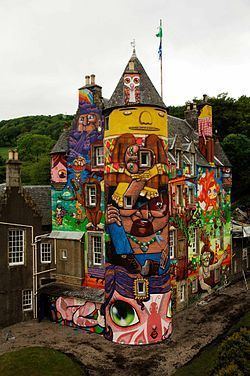Designated 14 April 1971 Designated 1987 Built 16th century | Reference no. 7294 Opened 1200 | |
 | ||
Criteria Work of ArtHistoricalArchitecturalScenic Similar Great Cumbrae, Kelburn Castle and Estate, Mount Stuart House, Cathedral of The Isles, Dean Castle | ||
Kelburn Castle is a large house near Fairlie, North Ayrshire, Scotland. It is the seat of the Earl of Glasgow. Originally built in the thirteenth century (the original keep forms the core of the house) it was remodelled in the sixteenth century. In 1700 the first Earl made further extensions to the house in a manner not unlike a French château which is virtually how it appears today. In 1977 the house and grounds opened to the public as a country park. It is one of the oldest castles in Scotland and has been continuously inhabited by the same family for longer than any other. The castle is protected as a category A listed building, while the grounds are included in the Inventory of Gardens and Designed Landscapes in Scotland.
Contents
- Map of Kelburn Castle Kelburn Estate Fairlie Largs KA29 0BE UK
- The graffiti project on kelburn castle
- History
- Graffiti project
- Fire damage
- References
Map of Kelburn Castle, Kelburn Estate Fairlie, Largs KA29 0BE, UK
When it was found in 2007 that the castle's concrete facing would soon need replacing, Lord Glasgow invited four Brazilian graffiti artists to decorate the walls. This was still in place in 2011, when the Earl sought permission from Historic Scotland to keep the graffiti permanently.
The graffiti project on kelburn castle
History
The Boyle family have been in possession of the lands of Kelburn since the 12th century. In the late 16th century a tower house was built. This replaced an earlier structure, and may incorporate parts of the earlier masonry its eastern part. In the 17th century, orchards and gardens are recorded at Kelburn. David Boyle (1666–1733), a member of the Parliament of Scotland, was created Earl of Glasgow in 1703. He began the new north-west wing of the house, which was completed circa 1722. George Boyle, 6th Earl of Glasgow (1825–1890), added the north-east wing in 1880. Following the opening of the grounds to the public, the estate buildings and stables were converted in 1980, to provide a tea room, shop and visitor information.
Graffiti project
In 2007 experts told the owners of Kelburn Castle that its concrete facing would eventually need to be replaced to avoid further damage to the stonework. At the suggestion of his children, Lord Glasgow invited four Brazilian graffiti artists (Nunca, Nina and Os Gêmeos twins) to paint the walls. Historic Scotland agreed to the project, on the basis that the graffiti would be removed when the castle was re-harled. The project was featured on the BBC television programme The Culture Show. Also in 2007, Kelburn featured in another BBC programme, Crisis at the Castle which documented the financial problems of running the castle.
In September 2010 it was reported that Historic Scotland were putting pressure on Lord Glasgow to remove the graffiti, although this was later denied by both parties. In August 2011 it was reported that the Earl had formally written to Historic Scotland asking permission to keep the graffiti as a permanent feature.
Fire damage
The castle suffered minor fire damage on 16 February 2009, as a result of an electrical fault. The fire service was called to a blaze at around 1:45 am where flames had engulfed a top-floor room and spread to the roof. Around 25 firefighters battled the blaze for more than five hours before it was extinguished at around 7:20 am.
